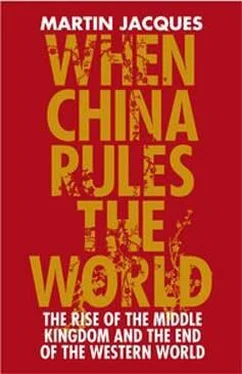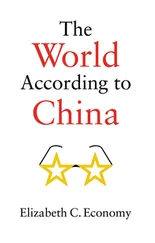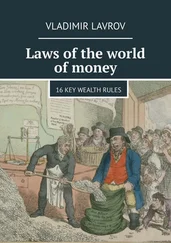No sooner had the new century begun than two developments suggested that a major change in their relationship was likely, even though it did not appear immediately obvious that this was the case. First, the Bush administration abandoned the previously consensual multilateralist US foreign policy in favour of a unilateralist policy that, amongst other things, embraced the principle of pre-emptive strike. The US turned away from its previous espousal of universalism and towards a nationalism which denied or downplayed the need for alliances. The new strategy placed a priority on military strength and hard as opposed to soft power, a position made manifest in 2003 with the invasion of Iraq. The principle of national sovereignty was subordinated to the desirability of intervention for the purpose of regime-change. A new and aggressive America was born. [1169] [1169] Lampton, ‘ China ’s Rise in Asia Need Not Be at America ’s Expense’, p. 318; National Security Strategy of the United States of America (Washington, DC: September 2002); Martin Jacques, ‘The Neo-Con Revolution’, Guardian , 31 March 2005.
In the event, an overwhelming majority of nation-states opposed the invasion of Iraq and, according to global opinion polls, an even more decisive majority of their citizens. As the occupation faced growing opposition and was perceived to have failed, the United States became unpopular to an extent not seen in the sixty years since the Second World War. [1170] [1170] Image of US Falls Again’, International Herald Tribune , 14 June 2006; ‘Un ease About Big Powers “Rising”’, 27 June 2007, posted on www.bbc.co.uknews; ‘Distrust of US Gets Deeper But Not Wider’, International Herald Tribune , 28 June 2007.
Second, around 2003-5, the moment of China arrived, as global awareness of its transformation, and the meaning and effects of that transformation for the rest of the world, suddenly began to dawn. By accident, these two developments happened to coincide, thereby serving to accentuate their impact. [1171] [1171] Interview with Shi Yinhong, Beijing, 26 August 2005.
It was widely acknowledged that China was on the rise and there was a slow dawning that the US was not as omnipotent as had previously been thought. There was a growing perception that the balance of power between the two countries was starting to shift in China ’s favour. [1172] [1172] Robert Ross, ‘Engagement in US China Policy’, pp. 179-80.
The mood in the United States towards China grew more uncertain. [1173] [1173] Kenneth Lieberthal, ‘Why the US Malaise over China?’, YaleGlobal Online , January 19 2006.
James Mann, in his book The China Fantasy , challenged what he described as the ‘Soothing Scenario’, namely the consensus which holds that engaging with China through trade will be to the political and economic advantage of the United States and will ultimately result in a free-market, democratic China. Mann argued that, notwithstanding China ’s market transformation, it by no means automatically followed that China would become democratic. [1174] [1174] Mann, The China Fantasy , Chapter 1.
The general mood of uncertainty and unease was accentuated by the credit crunch which started in summer 2007 and which a year later brought the American financial sector to its knees, with illustrious names like Lehman Brothers going bankrupt and the few remaining American investment banks forced to renounce their status — Goldman Sachs, the favoured bank of recent US administrations, amongst them. In an extraordinary volte-face, the government announced a huge bail-out of the financial sector, marking the demise of the deregulated neo-liberal regime which had been the calling card of American capitalism since the late 1970s. In a few spectacular weeks the Anglo-American model had imploded, plunging the Western economies into a serious recession. The fact that the US had been living well beyond its means — and relying on Chinese credit in order to do so — underlined both the fallibility of American prosperity and the shift in the centre of economic gravity from the United States to China.
There are a number of issues that seem likely to shape US attitudes towards China and increase the possibility of conflict between the two countries.
The first concerns American attitudes towards globalization. In the 1990s globalization was seen in the US as a win-win situation, a process by which the US left its imprint on, and gained advantage in its relationship with, the rest of the world. In effect, it was something that the United States exported to the world and then reaped the benefits from at home. [1175] [1175] Friedman, The Lexus and the Olive Tree , pp. 372-3.
Now, however, globalization is seen more and more like a boomerang that is returning to haunt the US. [1176] [1176] ‘ Red States and Blue Collars’, Financial Times , 3 August 2007. Hilary Clinton has expressed doubts about whether the Doha round should be revived; ‘Clin ton Doubts Benefits of Doha Revival’, Financial Times , 2 December 2007. There has been a major shift amongst mainstream economists, with growing scepticism about the virtues of globalization; Dani Rodrik, ‘The Death of the Globalization Consensus’, July 2008, posted on www.project-syndicate.org.
Previously, the US was regarded as the overwhelming agent and beneficiary of globalization. Now the main beneficiary is perceived to be East Asia, and especially China. [1177] [1177] Clyde Prestowitz, ‘The Yuan Might Shift; the Imbalances Won’t’, International Herald Tribune , 1 June 2005; Prestowitz, Three Billion New Capitalists , p. 193.
Through globalization, China has transformed itself into a formidable competitor of the United States, with its huge trade surplus, its massive ownership of US Treasury bonds, its consequent power over the value of the dollar, and the fact that it has undermined key sectors of American manufacturing industry, with growing numbers of workers being made redundant. The widening controversy over the value of the renminbi, the safety of Chinese exports such as food and toys, and the frequent accusations of ‘unfair’ competition, are a reflection of growing sensitivity towards China. [1178] [1178] Kynge, China Shakes the World , pp. 220-21.
This is not to suggest that the balance of American opinion has shifted significantly as yet. The winners, above all the US corporate giants that have moved their manufacturing operations to China and the consumers who have benefited from China prices at home, still considerably outnumber the losers and in any case enjoy much greater power. [1179] [1179] Mann, The China Fantasy , pp. 59–63.
But this could change. The political consequences of spiralling commodity prices, especially oil prices, which were brought to a premature end by the credit crunch, could, if they had continued, have turned American attitudes towards China in a more negative direction. More pertinently, the threat of a serious and prolonged depression is already leading to growing demands for protection. [1180] [1180] David Pilling, ‘The President-Elect Must Ease Asian Anxieties’, Financial Times , 5 November 2008.
It is striking that, even before the credit crunch, the number of Americans who thought that trade with other countries was having a positive impact on the US fell sharply from 78 per cent in 2002 to only 59 per cent in 2007. [1181] [1181] Pew Global Attitudes Project, World Publics Welcome Global Trade — But Not Immigration , 4 October 2007, posted on http://pewglobal.org, p. 14.
In the longer term, as Chinese companies relentlessly climb the technology ladder, the US economy will face ever-widening competition from Chinese goods, no longer just at the low-value end, but also increasingly for high value-added products as well, just as happened earlier with Japanese and Korean firms. [1182] [1182] For respective figures for the number of science and engineering graduates and doctorates in China and the US, with the latter comparing unfavourably, see Prestowitz , Three Billion New Capitalists , pp. 132-4. Also, David M. Lampton, ‘What Growing Chinese Power Means for America ’, hearing before the US Senate Committee on Foreign Relations, East Asian and Pacific Affairs Sub-committee, 7 June 2005, pp. 4, 6.
In that process, the proportion of losers is likely to increase rapidly, as will be the case in Europe too. Such a development could undermine the present consensus in support of free-trade globalization and result in a turn towards protectionism, the most important target of which would be Chinese imports. [1183] [1183] Kynge, China Shakes the World , pp. 108-14, 117-21, 212-13.
The impact of the depression, however, suggests that this process may already be happening. If the United States did resort to protectionism, one of the key planks in the Sino-American relationship since the early eighties would be undermined. It would also signal a more general move towards protectionism worldwide and the end of the phase of globalization that was ushered in at the end of the 1970s. The failure of the Doha round is a further indication that this kind of scenario is possible. [1184] [1184] Martin Jacques, ‘The Death of Doha Signals the Demise of Globalisation’, Guardian , 13 July 2006.
Читать дальше












